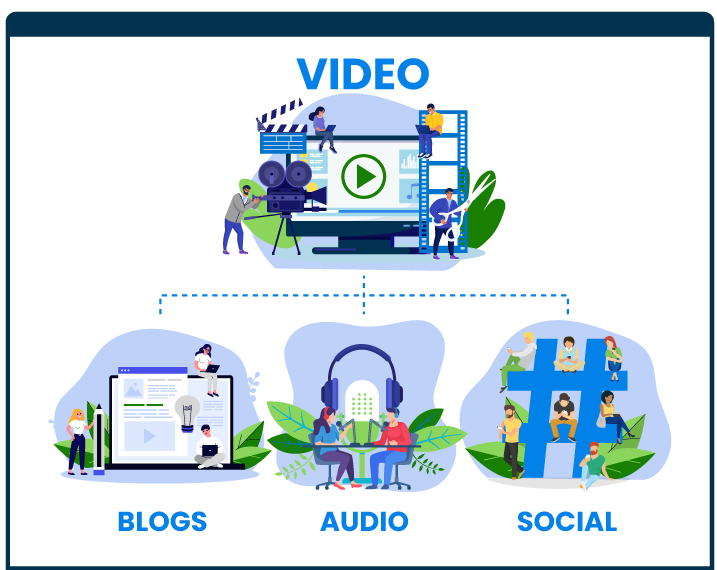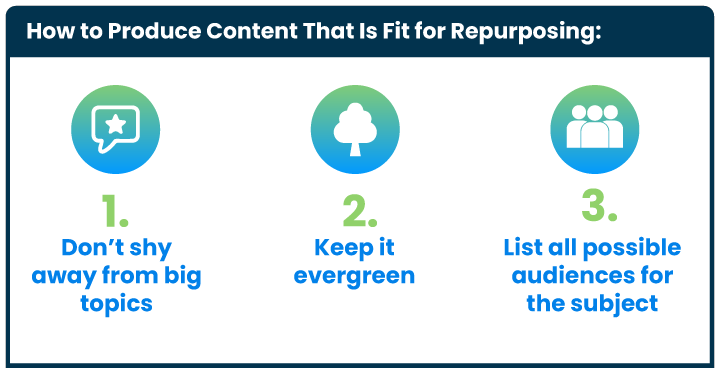
Content repurposing is a great way to save time and create more value for your customers—but it shouldn’t just be an afterthought.
SEO consultancy firm, Reboot, explain why repurposing content should be a major part of your content strategy, the advantages of transforming content into different mediums, and which types of content you should produce to achieve these benefits.
Why You Should Factor Content Repurposing Into Your Content Strategy
Content repurposing is taking existing content and modifying it for a different medium. If you know how to create outstanding content, it's an opportunity to take your best ideas and make them even better.
It's also a great way to save money because you can turn one piece of content into multiple places without having to create something entirely new each time.
Here are five reasons why you should factor content repurposing into your content strategy:
- It saves time. Perhaps the number one reason why companies opt for content repurposing is to save time and resources. Instead of producing ten pieces of content from scratch, they can create one and get the most out of it.
- You’ll get better engagement rates. Sometimes, an article doesn't get as much interaction as you'd like. With repurposed content, you can show people the same information in different ways so they can engage with it more easily.
- It will diversify your content. Not everyone likes the same type of media and you don’t want them to disregard your brand if they don’t connect with any of your content. Content repurposing can help your company be more dynamic and reach potential customers you may have otherwise missed.
- You’ll beat writer’s block. Nobody can be 100% creative all the time. All of us feel like we’re out of ideas at some point and repurposing content can help to still produce new material for your audience without having to think of a brand new concept.
- Cover every part of the marketing funnel. Taking your existing posts and turning them into something also with a different intent can help to produce content for all stages of the content marketing funnel—making it easier to guide your audience to a conversion.
SEO Benefits of Content Repurposing
Repurposing isn’t just great for saving time and resources, there are several SEO reasons why you need to start creating content that is fit for repurposing.

Greater Chance of Backlinks
Any good SEO company will be able to tell you If you aim to create a high-quality initial piece of content that has the potential to be repurposed into different types of media then you’re increasing the likelihood of authoritative sites linking to it. After all, some sites may be more likely to add a backlink to a video while others prefer linking to a blog post.
Higher Probability of Answering Search Intent
Search intent is the reason behind a search enquiry—it’s why people have typed that into Google. Although it’s easy to know what the search intent is of most keywords, some are a little vague.
For example, if someone is searching “best places to eat in London”, they may be looking be a listicle-style blog post, a long video showing the best restaurants in London for different cuisines, or a short-form TikTok video with a rundown of London’s eateries.
If you’re producing content that answers more than one of these intents, your traffic and views will almost certainly increase.
Can Attract More Search Traffic
It may seem obvious. After all, more pieces of content=more traffic on each one, right? Only if you do it well.
If you factor content repurposing into your initial content strategy then you can create pieces that will be attractive to different areas of your audience—giving you the chance to increase your overall traffic.
Say you’re an eCommerce site with a pretty wide variety when it comes to the ages of your target audience. If you’re only producing content that appeals to an older group without repurposing it to interest the younger of your customers, you’re losing out on a lot of search traffic.
Content Cannibalisation and Repurposing
What Is Content Cannibalisation?
Content cannibalisation is when you have too many of the same (or semantically similar) keywords packed into different pieces of content throughout your site. It results in Google—and other search engines—having trouble figuring out which piece of content should rank higher on the SERPs.
It also means you’re not able to control which pages to prioritise and can end with a short, informational blog post ranking highly rather than one of your more important, transactional pages.
How to Avoid Content Cannibalisation When Repurposing Content
If you don’t want to spend your time solving duplicate content issues, then you need to be aware of cannibalisation before repurposing. You don’t want your hard work to be stamped out when you see your pages competing with each other on the SERPs. So, when you’re planning your first piece of content (with the view of later repurposing it), make sure you:
- Target different keywords. Try to choose a different set of keywords to target—this is especially important if you’re changing a piece of written content into another written media e.g. a blog post into a landing page. They need to be separate enough that Google doesn’t view them as semantic keywords but still within the same subject.
Cater to different use intents. We’ve touched upon this before but search engines try to only show results that answer the search intent. If you repurpose content that was originally intended to answer informational queries into a piece that was made to satisfy transactional searches, then you won’t run into any cannibalisation problems.
Which Types of Content Lend Themselves to Repurposing
Content repurposing isn’t a new digital marketing trend, but it’s one that a lot of people forget. If you’re looking to centre a part of your content strategy around repurposing, then you need to know which types of content are the easiest (and most worthwhile) to start with.

Videos
The possibilities are almost endless when it comes to repurposing video content because so much more is usually said, or shown, in videos that don’t always make it into written content. Here are a few ideas about what you can transform your video into:
- An expert blog post
- Short clips to share on social media
- Audio (ideal if you’re looking to appeal to people on the go)
Long-form Articles
Longer articles are another repurposing dream because there’s just so much to work with. Each section can be transformed into a new media or, if the subject’s open enough, be turned into a few separate blog posts. If you’re looking for a few fresh ideas for your long-form articles, turn them into:
- An infographic
- An educational course
- Video tutorials
Podcasts
Podcasts spawn plenty of opportunities for repurposing. Off-hand quotes can make perfect social media posts to further the conversation on a different platform. You can also turn sections of the podcast into:
- Videos with visuals
- An interactive website asset
- Social media graphics
How to Produce Content That Is Fit for Repurposing

1. Don’t Shy Away From the Bigger Topics
Although you may be tempted to shy away from some of the bigger topics in fear of not being able to cover all the important parts, or not doing them justice, you have more opportunities with content repurposing.
When creating your content calendar, try to tackle subjects that have a large amount of information involved. You can then start to create a whopping piece for your starting content and go from there—just make sure you’re adding value each time.
2. Keep It Evergreen
Outdated data or information isn’t useful to anyone. If you’re looking to create content with repurposing in mind, keep it centred around evergreen subjects (things that don’t go out of date) to really get the most out of it.
That doesn’t mean you can’t work on pieces that include data or statistics though—just make sure you schedule regular updates into your content calendar to ensure they’re always up-to-date.
Know Every Section of Your Audience
By really diving deep into your audience personas and dividing them into categories such as gender, age, and location, you can come up with a pretty in-depth plan for your content repurposing.
Different pieces of media appeal to different people, so by knowing what type of people you’re trying to attract the attention of, you can figure out not only what your first piece of content will be but also every other piece it should be turned into.
How Long Should You Wait Before Repurposing Your Content?
There’s no exact timeframe for when you can repurpose different pieces of content, but here are a few guidelines to keep in mind.
Paid content benefits from a “cooling down” period. For example, you should wait a while before transforming any online courses or content from platforms with tiered benefits into different pieces—making sure you’re getting the most you can out of them before giving parts of the information for free.
However, most content can be repurposed immediately. Just posted a video? Get started on preparing the transcript for a blog post. Pushed a brand new landing page live? Use a couple of the graphics from it to create social media posts to promote it.
With this in mind, it’s clear that your content strategy shouldn’t just be about always looking forward to the next piece of content you have to produce—whether you’re a content marketing agency or an in-house team looking to make an impact. You need to make sure you get the most out of every piece of work you put out.
Share this post
Leave a comment
All comments are moderated. Spammy and bot submitted comments are deleted. Please submit the comments that are helpful to others, and we'll approve your comments. A comment that includes outbound link will only be approved if the content is relevant to the topic, and has some value to our readers.


Comments (0)
No comment